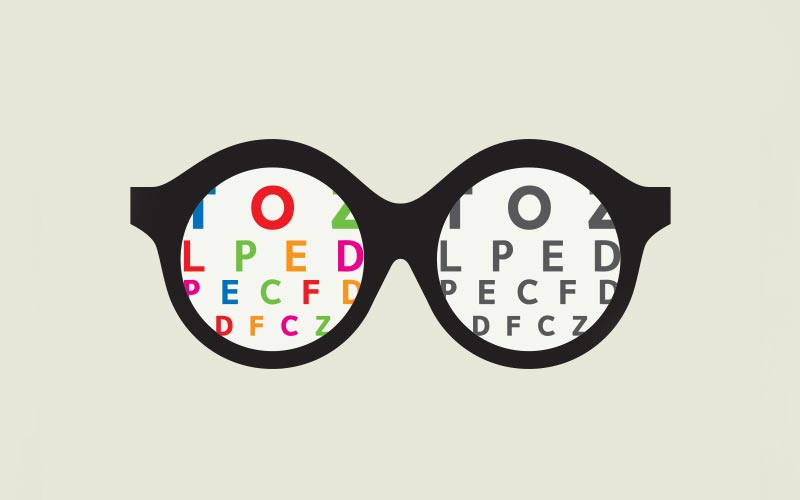Human eyes function more efficiently and less strenuously when seeing at distance. Working a computer, visual display terminal (VDT) requires use of your eyes at a closer range, usually intensely, for long periods of time. This alone can strain your eyes and may cause vision problems to develop or aggrevate existing vision conditions.
Typical computer work involves shifting the focus of the eyes from document to keyboard to screen, on average at least once every second. This unnatural situation is often the cause of eye strain and operator stress.
Eyestrain:
Eyestrain is a term used to describe a wide range of symptoms including tiredness, irritation and soreness of the eyes, screwing up of the eyes, photophobia (discomfort in bright light) and headaches. Eyestrain is often the cause of frontal headaches and relief can mostly be obtained by means of prescription lenses, contact lenses or vision therapy.
Due to the intense demands made on the visual system, people using VDT’s are more prone to suffer from the above symptoms. These can be brought about by various factors, including refractive errors, eye muscle imbalances, incorrect sitting postures, design limitations of the equipment, unsuitable lighting and office surroundings and psychological factors.
Fortunately most VDT-related vision problems can be easily alleviated through proper workstation planning, work habits and most importantly, professional eye care.
Common symptoms of computer terminal eye strain:
- Headaches
- Tired sore eyes
- Eye Irritation
- Blurred vision
- Slow refocusing when looking from copy or screen to distant objects
- Frequently losing place when moving eyes to screen and vice versa
- Difficulty in seeing clearly at distance after prolonged use of a computer terminal
- Occasional or frequent double vision
- Changes in colour perception
- Present lens prescription failing to relieve symptoms
Other symptoms from which computer operators may suffer:
- Neck, shoulder tension or pain
- Back pain
- Excessive physical fatigue
- Increase in irritability when using VDT’s
- Pain in arms, wrists (Carpal tunnel syndrome)
- Increased nervousness
- Lowered visual efficiency and increased frequency of errors
VDT workstation suggestions:
Many vision and stress problems can be alleviated by making changes in your working environment. Consider the following for optimising your VDT positioning:
- Make sure the terminal is not placed in such a way that the operator sees only the screen or a wall behind the screen
- Try to provide the opportunity to look well beyond the screen, out into open space
- VDT screens should be slightly below eye level (15 to 20 degrees)
- Copy or documents being read should be at the same level as the screen
- The screen should be positioned 500-600mm from the operators eyes
- Position the keyboard so that the wrists and lower arms are parallel to the floor (raise chair or lower desktop)
- Chairs should provide proper back and leg support and the height adjustable
- Adjust the chair height so that the feet are flat on the floor or rest on a foot support with thighs parallel to the floor
- Adjust the work table so that legs and knees clear it’s underside
Office equipment technology is constantly being improved to the ergonomics of the working environment.
Lighting – A vital factor:
One of the main causes of complaints from VDT operators is glare. Steps should be taken to avoid this problem which can occur as a result of reflections from the surfaces of the VDT screen and from other contrast between the text, screen and surroundings. The idea is to have even, comfortable illumination. Consider the following:
- Lighting in the work environment where VDT’s are used should be as indirect as possible
- Flourescent ceiling fans should be fitted with diffusers. If it is possible, lighting should be beamed upwards to diffuse at the ceiling
- Computer workstations should be provided with adjustable shaded copy lamps that can be moved by the operator to minimise screen glare
- Match as closely as possible the brightness of the surroundings with that of the VDT screen for an optimum comfort and efficiency. However, the constrast between the characters, the screen and the background should be high
- Minimise reflected glare on VDT screens by having VDT’s positioned away from windows and other sources of bright lighting. Use window shades, vertical blinds or curtains to block out excessive sunlight
- Adjust the VDT contrast and brightness to achieve the most comfortable viewing level. These adjustments need to be done at different times during the day if the work environment is influenced by altering levels of daylight
- Anti-glare screens are available
Maintenance of the computer terminal:
Regular maintenance of VDT’s is essential to avoid, for example, a reduction in brightness, contrast and legibility. Older VDT’s in particular, tend to require regular focus and alignment – resetting to ensure visual sharpness and avoid flickering and movement of the display. Diminishing screen images, clarity will lead to significant eye strain and operator stress.
For the best operator performance and efficiency:
- Look up and away from the VDT every few minutes
- Take frequent short breaks
- Have a comprehensive optometric examination annually. Make sure your optometrist knows about your current VDT use








